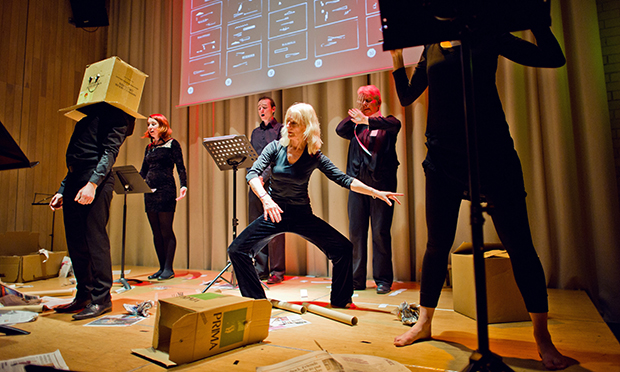Vocal Constructivists: the Stoke Newington choir with a graphic approach to music

Vocal Constructivists perform Lektura at The Forge, Camden, November 2012. Photograph: Monika Chilicka
How can you ‘play’ a series of squiggles, or dots, or wavy lines?
I loosely paraphrase a question posed by my 13-year-old self in a school music class. We were being introduced to graphic scores, a way of representing music through visual symbols outside the realm of crochets, quavers, treble clefs and the like.
Graphic scores as we know them began in the 1950s, as avant-garde composers such as Krzysztof Penderecki and Karlheinz Stockhausen began integrating noises, effects and electronic interventions into their compositions.
These composers found traditional notation limiting and sought new ways of conveying information to the performer. Instead of five horizontal lines and various dots thereon, they employed geometric shapes, abstract patterns and symbols, which gave performers interpretive freedom and meant no two renditions would sound alike.
Vocal Constructivists is a Stoke Newington experimental chamber choir that performs graphic scores. It was founded by Jane Alden, a choral singer with a traditional choral background who was so fascinated with one particular graphic score that she formed a group to perform it.
That score was the epic 193-page Treatise, composed by Cornelius Cardew between 1963–67. Once called the ‘Mount Everest’ of graphic scores, Treatise is inspired by the philosopher Ludwig Wittgenstein and consists of numbers, shapes and symbols, whose interpretation is left to the performer.
A chance meeting in 2010 with Michael Parsons, a composer who in the 1960s helped found the experimental Scratch Orchestra with Cardew, sowed the seed from which Vocal Constructivists bloomed.
“I was at Tate Modern in 2010 and looking at all this constructivist influenced art when I ran into someone who said that’s Michael Parsons over there. So I boldly went up and said I’m really interested in Treatise and was wondering if you think it’s ever been realised just by singers. He said he didn’t think it had.”
Five years on, and a group that formed for the sake of one composition is still together, performing a programme at last month’s Stoke Newington Contemporary Music Festival inspired by the centenary of early abstract artist Kazimir Malevich.
“I’d say we’re moving in the reverse direction,” Alden says, comparing their experiments in sound with abstract art. “The whole idea of making a vase and flowers look like a vase and flowers was turned upside down by the development of form, the idea that form is what is ultimately interesting rather than the content.
“Whereas what we’re doing is looking at scores that are deliberately ambiguous, so a composer might give us a vase and two flowers and it’s up to us to use our imaginations to see what we can get out of it.”
Alden sings in the New London Chamber Choir, and the group she originally assembled consisted of fellow choristers. Now though it is more of a mix; some members have a background in improvisation, others can’t read music at all, which means talking about music in a language accessible to all.
“I originally formed the group but it’s evolved in a participatory way,” says Alden. “We’re saying let’s see what the performers can bring to the table, rather than how the composer wants it, and what is interesting about it is that the parameters are so completely open.”
After the high point of the 1950s and 60s, graphic scores became deeply unfashionable, with Cardew himself denouncing his own avant-garde work, including Treatise.
Now, however, graphic scores are experiencing a comeback of sorts, with the likes of Aphex Twin and Sonic Youth amongst those who have used them. Is this a symptom of the ever-increasing role of computers in music, or does it run deeper?
“We’re in a period where people are looking at the radicalism of the 60s and 70s wistfully,” says Alden. “Maybe people are getting interested again because it represents a kind of freedom that people hanker after now. But whether or not we can achieve it is a different question.”
vocalconstructivists.com
